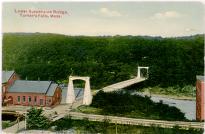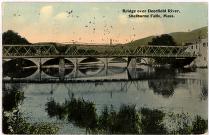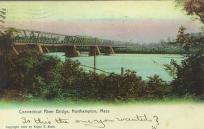|

Lower Suspension Bridge, Turners Falls, Mass.

Bridge over Deerfield River, Shelburne Falls, Mass.

Electric Car Bridge over Deerfield River, Shelburne Falls, Mass.

Mt. Sugar Loaf

Connecticut River Bridge

Upper Suspension Bridge and View of Riverside, From Prospect Street, Turners Falls, Mass.

Railroad Arch Bridge, Deerfield

B. and M. and Street Ry. Bridges at Cheapside
|
Summary and Objective
Students will understand that the design and construction of bridges has an impact on the social and economic development of local towns and villages. Using the American Centuries web site, students will explore the design, function, and societal impact of bridges constructed between 1800 and 1910. Students will strengthen their knowledge of bridge design by analyzing historical examples. Students will discover new perspectives on how bridges can make people's lives easier.
Teaching Plan
Step 1.
In preparation for this activity, the class will view the photograph "B. & M. and Street Ry. Bridges at Cheapside" from the digital collection and read the label that accompanies it.
Step 2.
Students will produce a 3-5 minute free-write response to the prompt: "How do you think bridges make people's lives easier?"
Step 3.
In small groups, students will work cooperatively to select three bridges from the digital collection, choosing an example to represent each of the three major bridge types: arch, beam, and suspension.
Step 4.
Using information from the American Centuries web site and Extra Links, each group will determine the following for its three bridges: type; year built; materials used; location; function; and status.
Step 5.
Students will brainstorm and discuss within their groups how each bridge might have influenced social and economic development during the period(s) it was in use.
Step 6.
Each group will briefly report to the class about one of the three bridges it studied.
Step 7.
Following the group reports, students will produce a 3-5 minute free-write response to the prompt: "How did bridges influence social and economic development from 1800 to 1910?"
Step 8.
At the conclusion of the free-write, students will be asked to list three questions that they would like to have answered about the bridges they studied.
|




